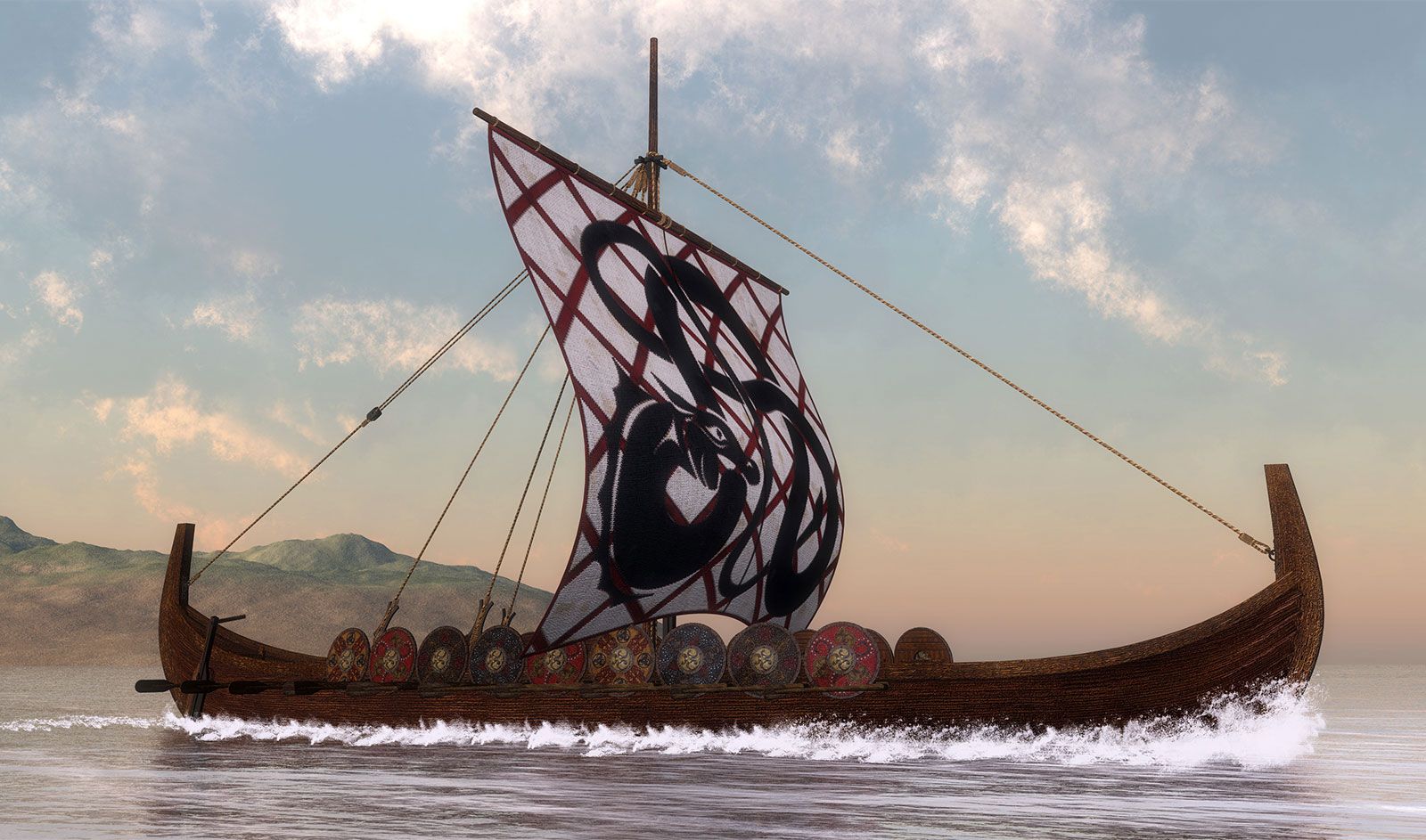Viking longships were amazing vessels. They sailed the seas during the Viking Age. This period lasted from about 793 AD to 1066 AD.
Vikings used longships for raiding. They attacked coastal towns and monasteries. These raids brought wealth and fame.
The key to their success lay in the design of the longship. Equipped with a shallow draft, these ships could navigate both open seas and narrow rivers, making them ideal for reaching remote inland cities that felt safe from invaders.
Longships allowed for quick beach landings, enabling Vikings to conduct swift hit-and-run raids. Their vessels could be launched rapidly, whether the raid was complete or if defenses were too strong. This agility made them formidable.
Vikings made efficient use of space on their longships. Oarsmen sat on sea chests, and shields were hung on the sides, maximizing room for plunder.
These ships used both sails and oars. With a favorable wind, they could reach speeds of 20 knots. In tight situations or poor weather, they relied on oars, reaching six knots for short bursts. To maintain stealth, they would lower masts and sails near the coast, making it harder for potential targets to spot them.
In this way, the longship was not just a vessel, but a crucial tool in Viking conquests across Europe.
Design and Construction
Viking longships had unique designs. They were long, narrow, and fast. These ships were perfect for raiding and exploring.
- Longships had a symmetrical shape.
- The front and back of the ship were the same.
- This design made it easy to reverse direction.
Feature Description Length Up to 30 meters long. Width About 5 meters wide. Material Mostly oak wood. Sails Made from wool or linen. What truly set Viking longships apart was their shallow draft. This allowed them to traverse inland rivers and coastal areas with ease, enabling surprise raids and quick retreats. Their versatile length-to-width ratio of 9:2, later improved to 7:1, provided unparalleled speed and agility.
Viking shipbuilders ensured the hull, mast, and rigging worked as a cohesive unit, contributing to the ship’s strength and flexibility. The lightweight design even allowed the ships to be carried over land, a rare feature among vessels of the time.
Within these narrow ships, space was maximized efficiently. Oarsmen sat on sea chests, doubling as storage, while shields were hung on the ship’s sides to save room. The dual propulsion system of sails and oars meant the Vikings could adapt to varying conditions, whether chasing down targets or battling the elements.
The longship was not just a vessel; it was a powerful tool for exploration and conquest. Its innovative design influenced other cultures, like the Anglo-Saxons and Normans, who adopted similar shipbuilding techniques to bolster their own fleets.
| Feature | Description |
|---|---|
| Length | Up to 30 meters long. |
| Width | About 5 meters wide. |
| Material | Mostly oak wood. |
| Sails | Made from wool or linen. |
How Viking Longships Mastered Both Seas and Rivers
Viking longships were engineering marvels that deftly balanced strength and agility, allowing the seafarers to traverse both ocean waves and tranquil rivers with ease. Their standout feature was a shallow draft, which enabled them to sail in both deep and shallow waters. This meant Vikings could navigate into the heart of Europe through its vast network of rivers.
Key Features of the Longship Design
- Shallow Draft: This low keel design allowed the boats to float in minimal water, making it possible for Vikings to launch quick and surprise attacks along coastlines and rivers alike. Even when loaded with warriors and loot, these ships maintained their agility.
- Lightweight Construction: The slim and strong build meant that these ships could be effortlessly moved across land between different waterways, like the Dnieper and Volga. This lightness was crucial for strategic maneuvers such as avoiding enemy blockades or moving to new fronts rapidly.
- Versatile Hull Design: The longship’s flexible structure enabled it to handle a variety of maritime conditions. From the choppy North Sea to the quieter inland waterways, Vikings could adjust their routes with ease, targeting vulnerable trading centers and monasteries.
- Quick Launch and Recovery: Whether conducting raids or escaping pursuit, the design allowed for swift beaching and relaunch. This capability made for highly effective hit-and-run raids, minimizing risk while maximizing the potential for plunder.
In sum, the ingenious design of the Viking longship was central to its effectiveness, allowing Norse warriors to explore, raid, and trade across vast distances. Their ability to seamlessly transition from sea to river without losing momentum is what set these vessels apart and made them an enduring symbol of Viking prowess.
Understanding Viking Longships: Karvi, Snekkja, Skei, and Drakkar
Viking longships were marvels of naval engineering, each designed for specific purposes and reflecting unique characteristics. Here’s a breakdown of the differences among the primary types: karvi, snekkja, skei, and drakkar.
1. Karvi: Versatile Vessels
- Purpose: Used mainly for trade, fishing, and raids along coastal areas.
- Size and Design: Typically measuring between 55 and 75 feet in length, with six to 16 rowing benches.
- Characteristics: Known for a length-to-width ratio of 9:2, allowing these ships to be agile yet stable. A notable example is the Oseberg ship found in Norway, which included a T-shaped keel suitable for sail deployment.
2. Snekkja: Speed and Agility
- Purpose: Primarily a warship, ideal for rapid movements and small-scale raids.
- Size and Design: Around 56 feet long, these ships had a narrow width of just over eight feet and a shallow draught of 18 inches. They typically hosted at least 20 rowing benches.
- Characteristics: Updated from earlier designs, the snekkja featured a 7:1 length-to-breadth ratio, providing superior speed and maneuverability. It was the most commonly used vessel in Viking fleets.
3. Skei: Larger Combat Vessels
- Purpose: Made for warfare on a grander scale, suitable for longer voyages.
- Size and Design: These ships maintained the 7:1 ratio but were larger, with at least 30 rowing stations accommodating over 61 crew members. A historical discovery in Roskilde Fjord revealed a skei measuring 120 feet long, capable of carrying up to 100 men.
- Characteristics: Known for their size and capacity, skei longships could support heavier loads and more troops, making them formidable in large naval battles.
4. Drakkar: The Dragons of the Sea
- Purpose: Symbolic powerhouses for the richest Vikings, often used for display or prestige.
- Size and Design: Equivalent in size to the larger skei, yet distinctly characterized by elaborate decorations.
- Characteristics: While none survive today, historical descriptions emphasize their extravagant designs, including dragon or serpent figures on the masthead. The construction required extensive labor, far exceeding standard longships.
In summary, whether for commerce, conquest, or ceremonial display, each type of Viking longship served its purpose with unmatched craftsmanship and strategic foresight.
Impact of Regional Variations on Viking Longships
Viking longships were not a one-size-fits-all affair; their design and construction varied significantly based on regional requirements.
Norwegian Influence: Norwegian longships were characterized by deeper draughts. This design was a natural adaptation to the rugged Norwegian coastline, marked by deep bays and fjords. The deeper hulls allowed these ships to navigate the often challenging waters more effectively.
Danish Adaptations: In contrast, Danish longships typically featured a shallower draught. The geographic terrain of Denmark, with its numerous shallow waters and more open seas, necessitated a design that could handle these conditions better, ensuring efficient movement without the risk of grounding.
Swedish Characteristics: Swedish vessels, on the other hand, tended to be smaller in size. This was largely because they were frequently employed along the major rivers of what is now Russia. The rivers’ limited width and depth dictated a more compact ship design, facilitating navigation along these narrow waterways.
In summary, the distinct geographical features and practical needs of each region played a pivotal role in shaping the construction and functionality of Viking longships. These adaptations ensured that the vessels were well-suited to the diverse environments encountered by the Norse mariners.
The Significance of the Kvalsund Ship in Viking Shipbuilding History
In 1920, a groundbreaking archaeological discovery was made: a Viking ship emerging from the depths of a bog. This vessel, known as the Kvalsund ship, dates back to around 700 AD and holds remarkable importance in the evolution of Viking maritime technology.
Transition to Advanced Designs
The Kvalsund ship stands as a pivotal example in the transition from rudimentary rowing boats to more sophisticated seafaring vessels. A crucial feature that set it apart was its rudimentary keel. This innovation marked a significant advancement, drastically improving the ship’s strength and stability on water.
Pioneering the Use of Sails
Before this period, Viking ships were primarily propelled by rowing. However, the Kvalsund ship heralded a new era with its design hinting at the potential for wind propulsion. The presence of a keel suggested that this vessel could accommodate a mast and sail, paving the way for the Vikings to harness wind power. This adaptation likely marked the beginning of all Viking ships incorporating sails alongside oars, enabling their renowned seafaring and exploration feats.
A Milestone in Maritime Evolution
In summary, the Kvalsund ship represents a significant milestone in Viking shipbuilding. Its introduction of the keel and potential for sail usage illuminated a path toward the advanced longships that would later dominate the seas, facilitating trade, exploration, and possibly even conquest throughout Europe.
This discovery not only enriches our understanding of Viking innovation but also underscores their adaptability and mastery of the seas during the Early Middle Ages.
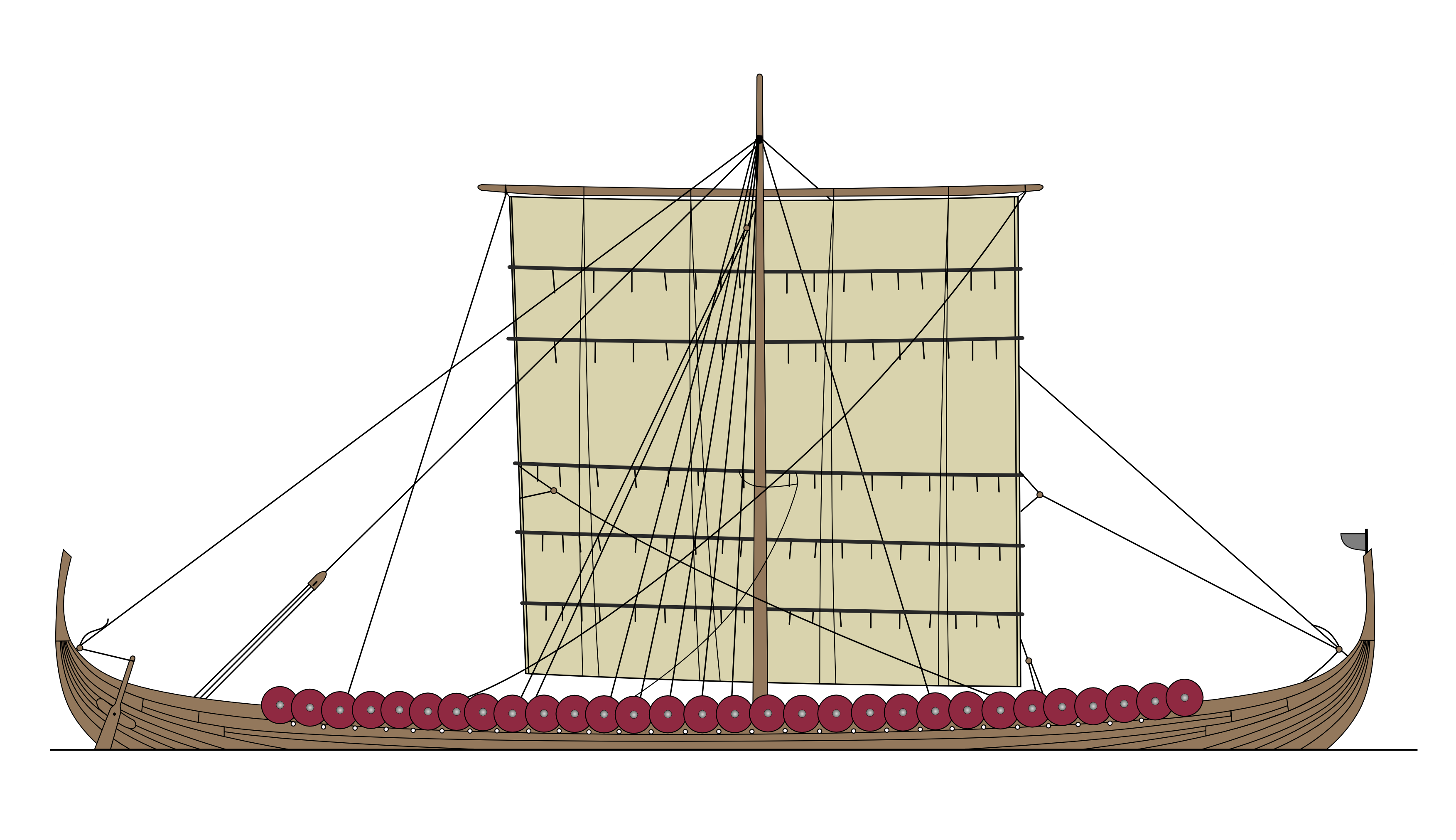
Navigation and Speed
Viking longships were fast and agile. They could sail at speeds up to 15 knots. The ships had both sails and oars.
Oars were used in shallow waters or near the coast.
Historical Significance
Viking longships played a key role in history. They allowed the Vikings to explore new lands. They also helped in trading and raiding.
The longship was a marvel of engineering that empowered the Vikings to conduct swift and successful raids. Its strong and slender build, combined with a very shallow draft, meant it could navigate diverse waterways, from seaports to shallow coves and navigable rivers. This versatility made it possible for the Vikings to reach and conquer lands far beyond Scandinavia.
The Viking Age, marked by the raid on Lindisfarne in 793 and concluding with the Battle of Hastings in 1066, was profoundly shaped by the development of the longship. These vessels transported Viking armies across Europe and enabled strategic amphibious assaults in estuaries and rivers.
Without the longship, the expansion and impact of the Vikings would have been limited. Recognizing its effectiveness, other kingdoms like the Anglo-Saxons and Normans adopted the longship design for their own fleets. Its influence endured until the 13th century when it was eventually replaced by the cog.
The longship not only facilitated exploration but also became a feared symbol of Viking prowess throughout Europe.
Viking Naval Battle Tactics with Longships
When it came to naval warfare, Vikings were formidable adversaries, employing a range of strategic maneuvers using their renowned longships. Here’s a breakdown of their tactics:
- Initial Assault: As the enemy fleets came into range, Vikings would launch a barrage of spears and arrows, aiming to weaken the opposing forces before direct confrontation. This ranged attack was an essential first step in softening the enemy’s defenses.
- Forming a Floating Battlefield: Upon closing in for battle, both sides would often lash their ships together, creating a stable platform on the water. This makeshift battleground allowed for more controlled combat, directly engaging their foes.
- Strategic Positioning: The flagship, typically the tallest with higher gunwales, was centrally placed within this floating array. This positioning gave Vikings a vantage point, making it difficult for enemies to overwhelm their command vessel.
- Grappling and Boarding: Vikings used grappling hooks to latch onto enemy ships, targeting those with lower gunwales for easier boarding. This enabled them to board enemy vessels swiftly, taking the fight directly to their adversaries.
- Close-Quarter Combat: Once on board, Vikings replicated their land tactics by forming a shield wall. This defensive stance allowed them to methodically advance, using axes, spears, and swords to dispatch opponents efficiently.
- Persistence in Battle: With the initial ship secured, Vikings would continue their aggressive assault, moving from vessel to vessel until they achieved victory. Their relentless approach and tactical prowess often determined the outcome in their favor.
By integrating meticulous planning with fierce combat skills, Vikings made their longships a powerful tool in naval warfare, ensuring their dominance on the seas.
How did the Vikings manage to conduct overland portages with their longships? The secret lay in the ingenious design of their vessels. Viking longships, including the nimble snekkja models, were exceptionally lightweight. This design allowed them to be easily transported over land when transitioning between rivers.
Their shallow drafts not only facilitated coastal raids and river navigation but also made them surprisingly easy to haul over short distances by land. The Vikings would drag these ships across narrow land segments—often using rollers or greased planks—to move between waterways such as the Dnieper, Don, and Volga. This portability was a strategic advantage, enabling the Vikings to explore and raid far-reaching territories that others couldn’t easily access by water alone.
Overall, the blend of superb craftsmanship in shipbuilding and strategic use of the terrain enabled the Vikings to master the art of overland portage, contributing significantly to their legendary expeditions.

Historical Significance
Viking longships were a cornerstone of Norse culture during the Viking Age (793–1066 CE), playing pivotal roles in exploration, trading, and raiding. Their innovative design and versatility made them essential for the Vikings’ maritime dominance and expansion across Europe and beyond.
Exploration
Viking longships were instrumental in enabling the Norse to explore uncharted territories.
- Transoceanic Voyages: These ships allowed the Vikings to navigate the North Atlantic, reaching distant lands such as Iceland, Greenland, and even North America (Vinland).
- River Navigation: Their shallow draft enabled access to inland rivers, allowing Vikings to penetrate deep into continental Europe and establish settlements in regions like Russia and the Baltic.
- The longships’ speed and maneuverability made them ideal for traversing rough seas and narrow waterways, facilitating unprecedented exploration.
Trading
The maritime innovations of the Vikings, particularly their mastery in crafting longships, had a profound impact on other cultures and kingdoms during the medieval period. The hallmark of Viking maritime expertise, the longship was pivotal for their expeditions and raids far beyond Scandinavian borders.
Influence on Other Cultures
- Adaptation by Other Kingdoms: Observing the strength and versatility of the Viking longships, several cultures, including the Anglo-Saxons and Normans, were quick to recognize their value. These communities adopted and adapted the design, integrating it into their own naval forces.
- Design Impact: The sleek, swift design of the longship, noted for its ability to navigate both open seas and shallow rivers, was a game-changer. This capability allowed other kingdoms to enhance their maritime strategies and expand their trade networks more efficiently.
- Legacy and Evolution: Such was the influence of the Viking longship that its design principles continued to be used extensively until they eventually evolved into the cog—a larger, sturdier vessel that began to gain prominence in the 13th century.
The legacy of the Vikings is clearly evident in how their maritime technology shaped naval engineering, trade, and exploration strategies of reaching future horizons. Through the adoption of their shipbuilding techniques, the Vikings left an indelible mark on the course of medieval naval history.
The Vikings were not only raiders but also skilled traders, using their longships to establish extensive trade networks.
- Commodities: They traded goods such as furs, amber, and slaves while importing luxury items like silver and spices.
- Cultural Exchange: Longships facilitated interactions between Scandinavia and other regions, spreading Norse culture while incorporating foreign influences.
These vessels allowed the Vikings to connect with distant markets, making them key players in medieval commerce.
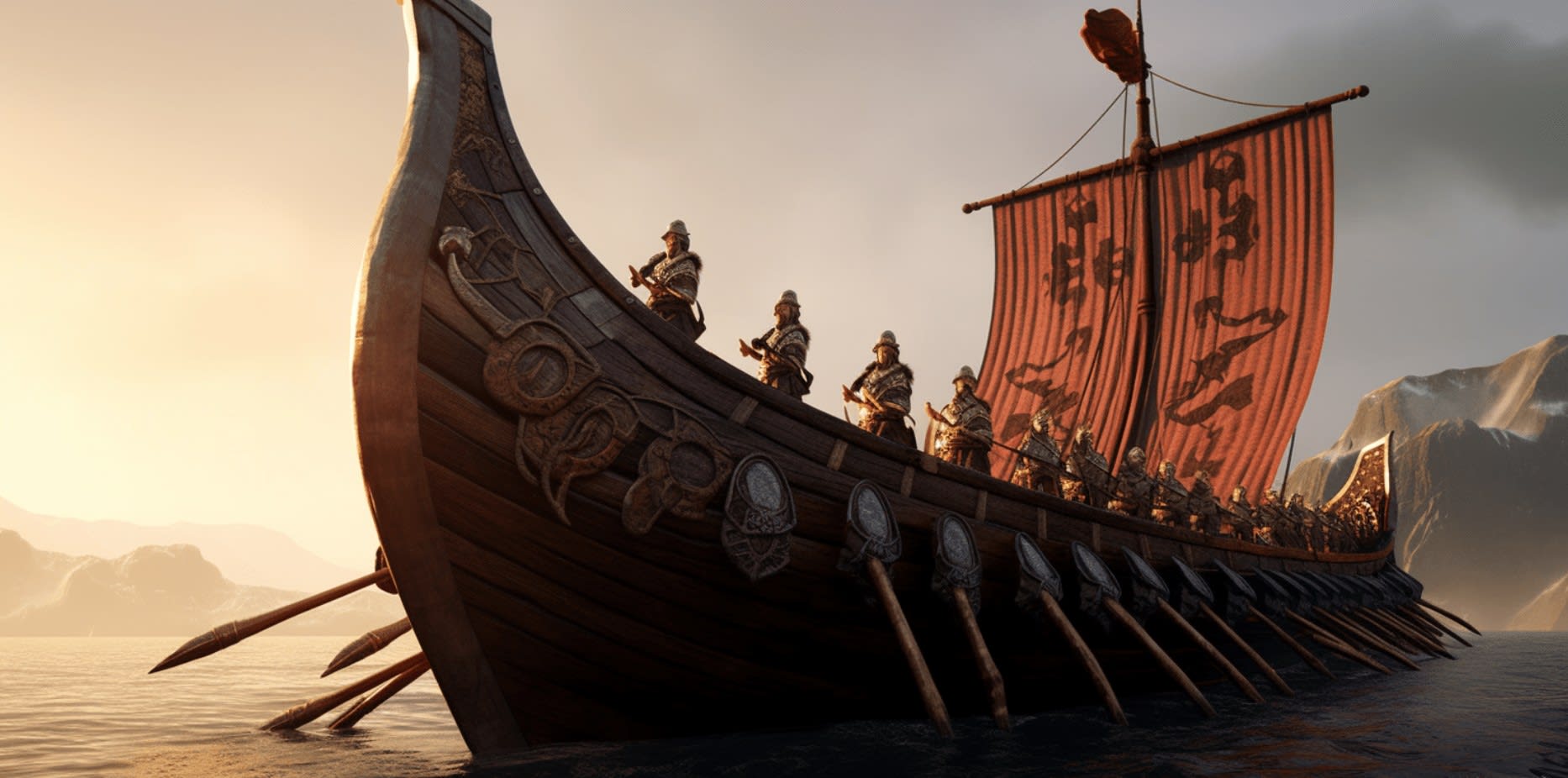
Raiding
When confronting formidable foes like the Byzantines, the Vikings demonstrated remarkable adaptability in their naval strategies. Central to this was their ingenious use of the longship, a versatile vessel that allowed them to maneuver swiftly and surprise their enemies. Unlike the larger, more cumbersome ships of their adversaries, Viking longships could navigate both the open seas and shallow river waters, facilitating quick retreats and surprise coastal raids.
To enhance their tactics, the Vikings often utilized the element of speed, launching swift attacks before enemy forces could fully rally. Their ships, designed for speed and agility, enabled rapid deployment and retraction in hostile territories, maximizing their advantage against less mobile fleets.
Furthermore, the Vikings‘ willingness to integrate and innovate played a crucial role. Observing the naval technologies of other cultures, such as the Byzantines, they incorporated advanced elements into their own fleet designs and combat techniques. This adaptability allowed the Vikings not only to engage the powerful Byzantine fleet but also to influence naval warfare for generations to come.
Longships became synonymous with Viking raids due to their tactical advantages.
- Hit-and-Run Tactics: Their speed and shallow draft enabled surprise attacks on coastal towns, monasteries, and inland cities via rivers like the Seine, Rhine, and Thames.
- Military Superiority: Longships could carry warriors swiftly to vulnerable targets and retreat before reinforcements arrived.
- Economic Gains: Raids brought plunder, slaves, and tribute payments, enriching Viking societies while striking fear into their enemies.
Viking longships were more than just vessels; they were symbols of Norse ingenuity and adaptability. Their role in exploration expanded Viking influence to new territories, their use in trading established vital economic networks, and their effectiveness in raiding secured wealth and prestige for Norse communities. These versatile ships remain iconic representations of the Viking Age’s maritime achievements and enduring legacy.
The Viking Longship: Key to Amphibious Assaults
The Viking longship was pivotal in enabling the Norse warriors to execute effective amphibious assaults across Europe. Known for its strong yet nimble design, the longship allowed Vikings to navigate diverse waterways—from the open sea to narrow rivers.
1. Versatile Navigation:
Viking longships were constructed to traverse various aquatic environments. They could glide over deep seas and move through shallow rivers that were often inaccessible to larger vessels. This capability allowed Vikings to strike targets along coasts and inland, reaching remote locations that were usually safe from seaborne invaders.
2. Swift Mobility and Retreats:
With their shallow draft, longships could be easily beached or launched, crucial for quick attacks and getaways. This feature enabled Vikings to swiftly raid coastal settlements, monasteries, and trading posts, gathering loot such as slaves and precious metals. After a hit-and-run raid, the ships could depart rapidly, making it difficult for local defenders to mount an effective counterattack.
3. Flexible Assault Strategies:
The design of longships was ideal for surprise assaults. Vikings could approach stealthily and land troops directly on target shores, thanks to the vessel’s ability to operate in both deep and shallow waters. This facilitated diverse tactical approaches, from sudden landings to coordinated assaults along rivers and coastlines.
These strategic advantages made the Viking longship not just a transport vehicle but a robust platform for executing their notorious raids across Europe efficiently. The longship thus became a feared emblem of Viking might, synonymous with their legendary and often unpredictable warfare tactics.
The Viking Longship: A Catalyst for Norse Expansion and Trade
The Viking longship was a revolutionary vessel that played a crucial role in Norse expansion and trade. These ships were not just tools for warfare but pivotal in expanding trade routes, especially in Russia and around Constantinople.
The Strategic Design of Viking Longships
The hallmark of the Viking longship was its light weight, which allowed for remarkable versatility. These ships, including the famed snekkja, could be transported over land between rivers like the Dnieper, Don, and Volga. This capability enabled the Vikings to navigate through vast river systems, thereby extending their reach deep into the heart of Russia and establishing vital trade networks.
Influence on Expansion and Trade Routes
In Russia, the longship was instrumental in connecting Scandinavia with the Byzantine Empire. Vikings, often referred to as Varangians in these regions, ventured south toward Constantinople, drawn by legendary tales of its wealth. Their ability to navigate diverse waterways fostered the establishment of significant trading routes, linking the Norse traders with the riches of the East and the Mediterranean.
Naval Power and Tactical Advantage
Unlike other contemporary ships such as those of the Greeks and Romans, which featured rams for sinking enemy vessels, Viking longships employed agile and fast tactics. They effectively utilized their maneuverability in naval battles against rival clans and external adversaries. This adaptability was not only critical in raids along European coastlines but also in confrontations around strategic locations like Constantinople.
Lasting Influence on Naval Architecture
The longship’s success did not go unnoticed. Its efficiency and versatility inspired other cultures, such as the Anglo-Saxons and Normans, to model their own vessels after it. This influence was a testament to the longship’s innovative design and the Vikings’ strategic use of it. The legacy of the Viking longship endured until advancements in shipbuilding led to the emergence of the cog in the 13th century.
In summary, the Viking longship was more than just a vessel; it was a pivotal tool that facilitated Norse expansion and the opening of new trade routes. Its impact on naval warfare and trade routes in Russia and around Constantinople was profound, shaping the course of Viking influence in these regions.

The Viking Longships: Strengths and Shortcomings in Battle
The Viking longships were a remarkable feat of engineering and craftsmanship, offering both significant advantages and notable limitations in battle scenarios.
Advantages of Viking Longships
1. Exceptional Speed and Maneuverability:
- Viking longships featured a shallow draft, allowing them to navigate through Europe’s interior rivers and shallow coastal waters with ease.
- Powered by both sails and oars, they could achieve impressive speeds—up to 20 knots with favorable winds—and maintain around six knots under oar power over short distances. This dual propulsion made them agile in battle and swift in retreats.
2. Stealth and Surprise Attacks:
- The ability to lower masts and sails made these ships less visible when approaching targets, enabling surprise raids on coastal settlements.
3. Tactical Design:
- With a length-to-breadth ratio of 7:1, these ships combined speed and flexibility, outclassing earlier naval designs of the period.
4. Versatile Combat Use:
- The Vikings could approach silently and lash their ships together to create stable platforms for fighting at sea, leveraging their experience and tactics from land battles.
Limitations of Viking Longships
1. Lack of Defensive Features:
- Unlike the heavily fortified warships of ancient Greece and Rome, Viking longships lacked structures like rams for attacking enemy vessels. Their design prioritized speed over defensive capability.
2. Limited Armament for Sea Combat:
- Engagements relied heavily on personal combat skills. Vikings mainly used spears, arrows, axes, swords, and shield walls, as opposed to more advanced naval weaponry.
3. Limited Crew Capacity:
- Longships were relatively small compared to other maritime vessels, which constrained the number of warriors they could carry and potentially put them at a disadvantage in larger fleet confrontations.
4. Vulnerability in Open Waters:
- While the shallow draft and light construction suited rivers and coasts, these attributes also made longships more vulnerable in rough, open seas or against heavily armed naval forces.
Despite these limitations, the Viking longships’ strengths in speed, navigation, and tactical versatility made them formidable assets in their quest for expansion and conquest. Their design reflects a keen understanding of the balance needed between rapid mobilization and effective combat—the very traits that etched Vikings into history as formidable warriors.
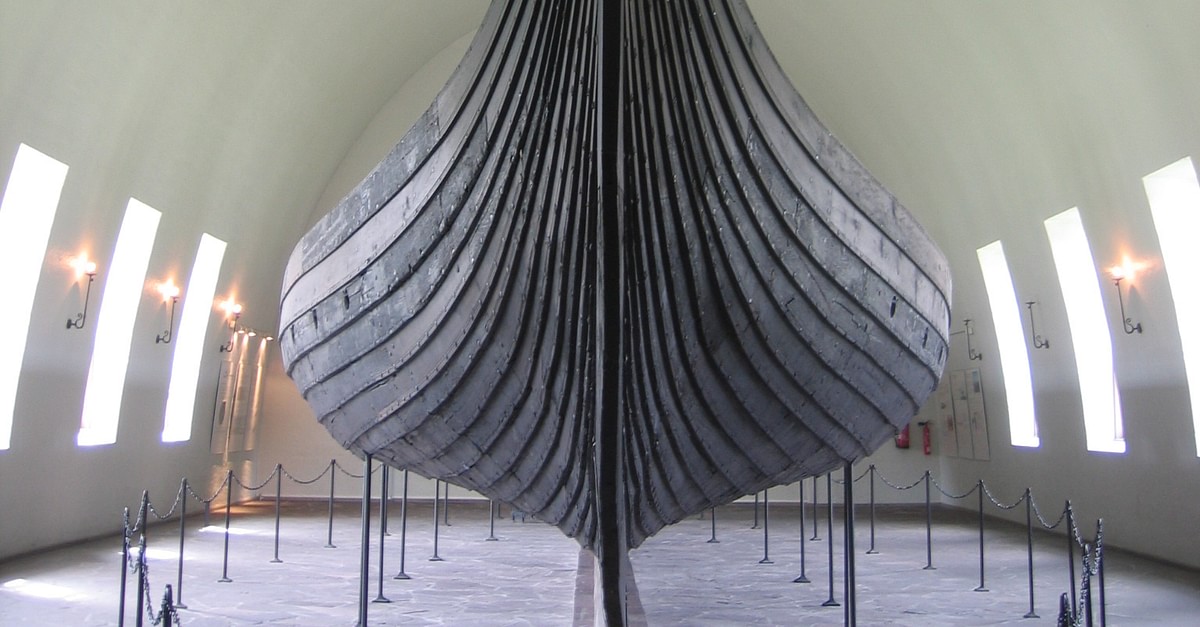
How Were Viking Longships Used in Naval Battles?
Viking longships played a pivotal role in their naval strategies, both in raiding and in battle against rivals and enemies. Unlike the warships of ancient Greece and Rome, Viking longships did not feature rams to pierce enemy vessels. Instead, they relied on tactics that mirrored their land combat techniques.
Strategizing with the Longship
When two fleets met at sea, the Vikings initiated combat by hurling spears and shooting arrows as they closed the distance. As the fleets drew near, they would lash ships together, creating a formidable floating platform for battle. This setup allowed them to use their strategic formations, such as the shield wall, directly on the water.
Positioning and Deployment
In these naval formations, the flagship often took the central position. Its higher gunwales provided a strategic advantage, making it an ideal spot for commanders. Meanwhile, smaller, agile ships flanked the assemblage to provide coverage and flexibility.
Capturing Over Destroying
Vikings typically threw grappling hooks to seize enemy vessels, focusing on those with lower sides to make boarding easier. Once aboard, they engaged in fierce close-quarters combat, wielding swords, axes, and spears until they overcame their opponents. The intention was often to capture ships, due to their high value and construction cost, rather than sinking them.
This approach not only allowed Vikings to expand their fleet but also conserve resources, sustaining their dominance on the seas.
How the Viking Longship Facilitated the Occupation of Seville in 844
The Viking longship was a marvel of engineering that played a pivotal role in the Norse success across Europe, including the occupation of Seville. Its unique features provided the Vikings with a strategic edge in their raids.
The Remarkable Adaptability of the Longship
The longship’s design was crucial for navigating various waterways, from broad seaports to the narrowest rivers. Its most significant feature was its shallow draft. This allowed the vessel to traverse shallow waters easily and access inland areas that others couldn’t reach, crucial for surprise attacks and swift retreats.
Strategic Maneuverability
In 844, this capability enabled Viking raiders to sail up the Guadalquivir River to reach Seville. The city’s strategic location was not its only attraction; the wealth it housed was the main lure, especially the gold-laden treasures of the great mosque.
A Temporary Stronghold
Once in Seville, the Vikings managed to occupy the city for six weeks. This bold occupation was only possible due to the longship’s ability to navigate swiftly and stealthily, even with the added weight of warriors and their spoils. Despite their eventual withdrawal in the face of stronger forces, the initial success showed how the longship allowed Vikings to extend their reach and hold strategic locations, even if temporarily.
In summary, the Viking longship was not just a vessel but a key enabler of the Viking operations that made significant incursions into European territories possible, such as the brief but notable occupation of Seville.
Cultural Impact
Longships were more than just ships. They were a symbol of Viking culture and power.
- Longships were often decorated with carvings.
- They had dragon or serpent heads on the prow.
- These decorations were meant to scare enemies.
Modern-Day Legacy
Today, Viking longships are still admired. Many museums have replicas of these ships. You can even find festivals celebrating Viking culture.
- Rosala Viking Centre in Finland.
- Viking Ship Museum in Norway.
- Jorvik Viking Festival in England.
The Enduring Legacy of the Viking Longship in Medieval Naval Architecture
The Viking longship stands as a pivotal innovation in medieval naval architecture, leaving a profound legacy on maritime history. Its design and functionality were revolutionary, enabling the Vikings to explore, trade, and conquer lands far beyond their Scandinavian origins.
Central to Expansive Voyages
The longship’s primary impact was its role as the backbone of Viking expansion. Its shallow draft and symmetrical design allowed it to navigate both open seas and narrow rivers, making previously unreachable territories accessible. This versatility facilitated the spread of Viking influence across Europe, dramatically altering the landscape of the medieval world.
A Model for Success
Kings and rulers from various regions, notably the Anglo-Saxons and Normans, took note of the longship’s success. They adapted and modified this efficient design for their navies, recognizing its superior speed and maneuverability. This cross-cultural adoption emphasized the longship’s reputation as a maritime game-changer.
Lasting Influence
The Viking longship’s impact endured until the 13th century, when advancements like the cog emerged. However, the principles of its design—streamlined for speed, durable for longevity, and versatile in application—remained influential. These characteristics laid the groundwork for future naval innovations, underscoring the longship’s enduring legacy in medieval naval construction.
In essence, the Viking longship not only transformed Viking society itself but also set a benchmark for naval design that inspired subsequent generations, leaving an indelible mark on medieval maritime history.
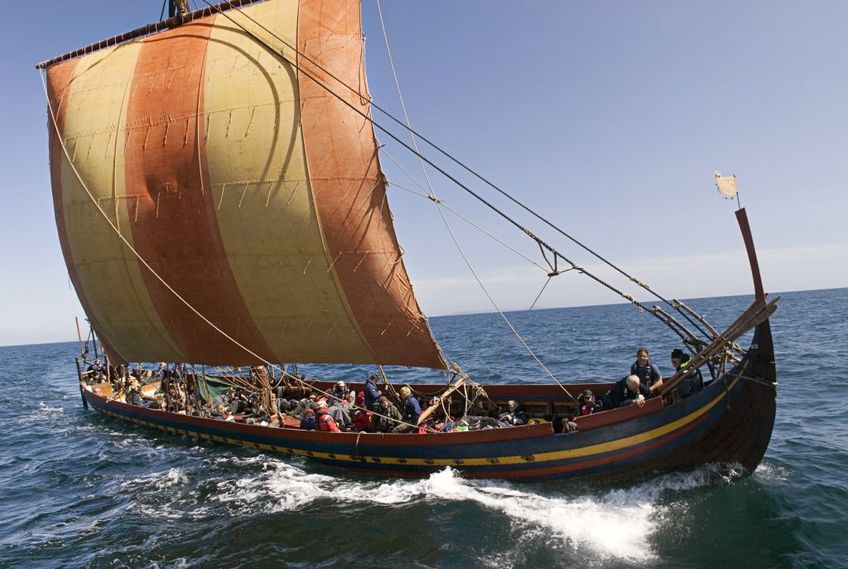
Frequently Asked Questions
What Is A Viking Longship?
A Viking Longship is a fast, versatile wooden ship used by Norsemen for trade, exploration, and warfare.
How Were Viking Longships Built?
Viking Longships were built using overlapping planks, known as clinker-built, with a keel for stability and strength. These overlapping planks, or strakes, were fastened with sturdy iron nails, providing a robust framework essential for the ship’s durability.
Viking shipbuilders skillfully hewed these planks using axes, following the natural grain of the wood. This technique not only maximized the wood’s inherent strength but also ensured the flexibility needed during construction. By aligning with the wood’s grain, builders could bend the planks during the ship’s final phase, achieving a remarkable balance between rigidity and adaptability.
The clinker-built design, combined with meticulous craftsmanship, allowed the longships to withstand the rough conditions at sea while maintaining agility and speed. This innovative construction technique was key to the Vikings’ naval dominance, enabling their ships to navigate both open waters and shallow rivers with ease.
What Materials Were Used In Viking Longships?
Viking Longships were made primarily from oak wood, with iron nails and woolen sails for durability and efficiency.
How Long Were Viking Longships?
Viking Longships varied in size, typically ranging from 45 to 75 feet in length, accommodating around 40 to 60 men.

